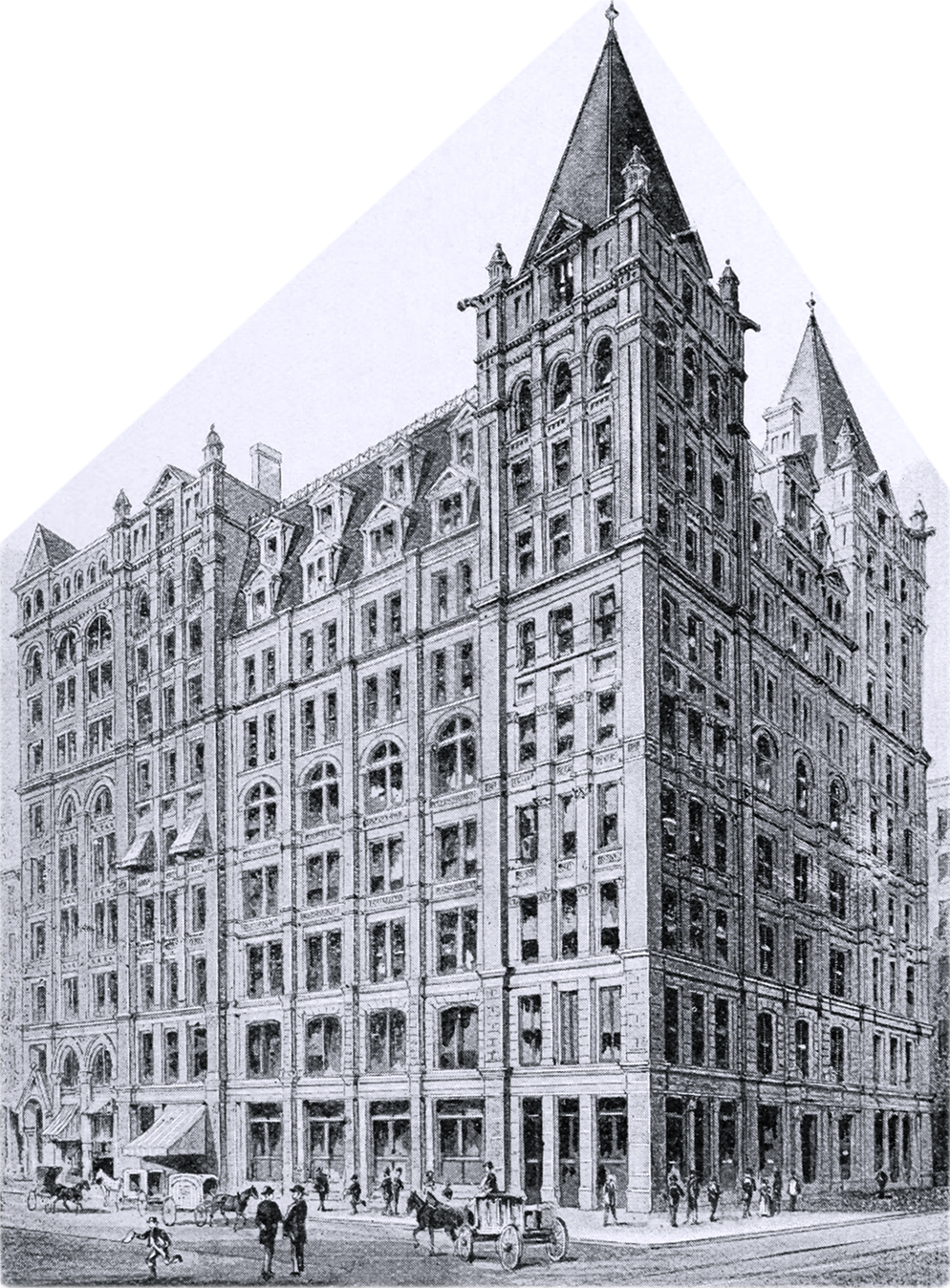
Temple Court Building - 1892
The historic Temple Court, Beekman Street, southwest corner of Nassau Street. Source: King’s Handbook of New York City … 1892, by Moses King.
The Temple Court Building (now The Beekman Hotel) was erected between 1881 and May 1883 at 5 Beekman Street as a 10-story office building, built by banker Eugene Kelly. It began to be occupied before July 1882. Below, text about the Temple Court published in the King’s Handbook:
«Temple Court, owned by Eugene Kelly, the veteran banker, is one of the finest office-buildings in New York. The structure is ten stories in height and comprises two sections, the first constructed about a decade ago, the other in 1889-90. They are joined together by passage-ways, and, united, form one of the largest office buildings in the city, with frontages on Beekman Street, Nassau Street and Theatre Alley. The situation is most convenient, being but a short distance from the Post Office, Printing-House Square and City Hall Park. It was on this site, in a theatre built in 1751 [1761], that Hamlet was first produced in America. [Continue below]

|
Copyright © Geographic Guide - Old NYC. Historic Building. |
Here, too, in those early patriotic days which "tried men's souls," a meeting took place in this theatre to give emphatic disapproval of the Stamp Tax in 1764. On this same site stood the former Clinton Hall and the Clinton Hotel. Clinton Hall was built for the Mercantile Library, which occupied a part of the building. Here was made an important part of the collection of books now so comfortably quartered in the present Clinton Hall, in Astor Place. The Clinton Hotel was one of the best of its time, and the table was particularly pleasing to old-fashioned New-Yorkers. Above the hotel, on the top floor of the building, were the rooms of the National Academy of Design, now located at 23d Street and Fourth Avenue. President Daniel Huntington of the Academy says : "In those days there were no 'lifts,' or elevators, but the apartments there were very fine. There was one room fifty feet square at least. We had a fine light, in fact, better light than the institution has had since. Then it was so spacious that we could get a good view of a large, full-length picture across the room. Since then the apartments of the Academy have been more numerous but smaller." It was here then that two of New York's notable institutions, the National Academy and the Mercantile Library, tarried and got that strength that enabled them to move into greater and more suitable structures. Here, too, the largest bank of the United States — The National Park Bank of New York — which to-day has the greatest amount of gross assets of any National or State Bank in the country, made its start, and for many years owned the greater part of the site of the Beekman-Street portion of Temple Court. It was from the Park Bank that Mr. Kelly, who for many years has been one of its directors, bought the property, when the bank made its move into its present quarters on Broadway. Thus the drama, art, literature and finance have all thrived on this spot, and it is appropriate to find here an edifice that is creditable in architecture and pleasing in nomenclature.
Temple Court is a modern building in every sense, it is thoroughly equipped with all the latest improvements. It contains five fine passenger elevators, which give quick and easy access to all the floors; Worthington pumps for supplying water ; and other modern conveniences. The Nassau-Street front, which presents an attractive and imposing appearance, is of light limestone imported from Balinasloe, Ireland; while the Beekman-Street side is of brick and stone, and is quite stately. The older part of the building has a spacious vestibule entrance with a large central court that runs from the ground floor to the tenth story. This gives light and ventilation, and a pleasant effect to the interior rooms. Some of the offices have open fire-places with mantels and grates, and the trim is in hardwood finish throughout. Temple Court is largely occupied by law firms, and other professional men and manufacturers. One of its finest suites of offices was occupied, until recently, by one of the United States Government departments. On the ground floor are the banking-rooms and safe-deposit vaults of the Nassau Bank.
The quaint towers of Temple Court, with their high pyramidal roofs, are unmistakable land-marks in the heart of New York, and point the way to the scenes of vast and momentous transactions in business and finance.
Temple Court Building - 1892
